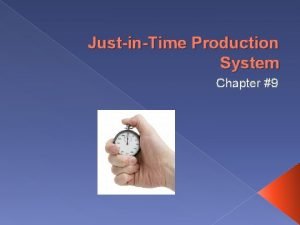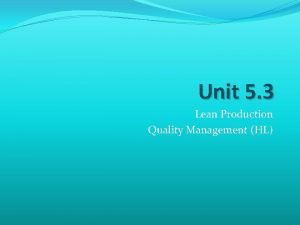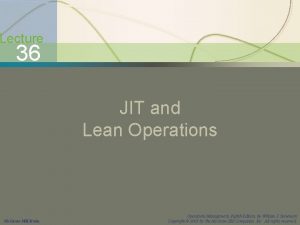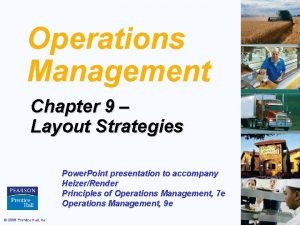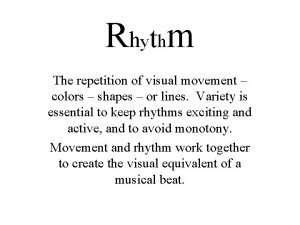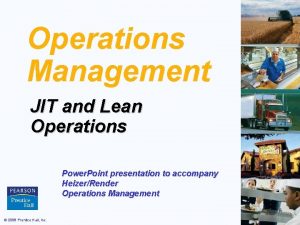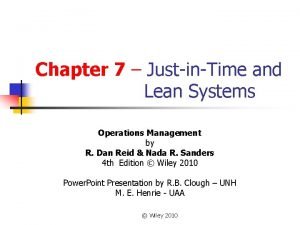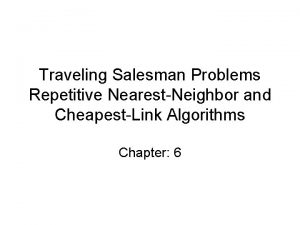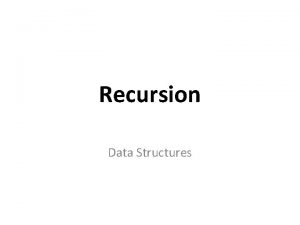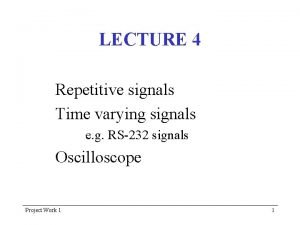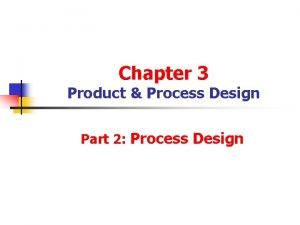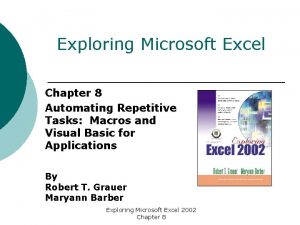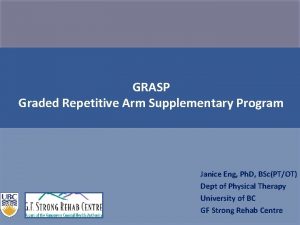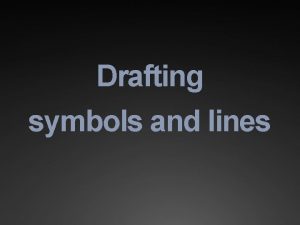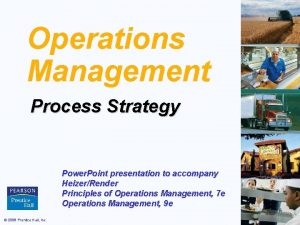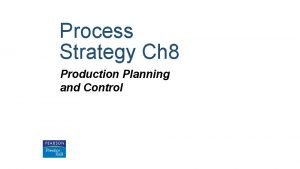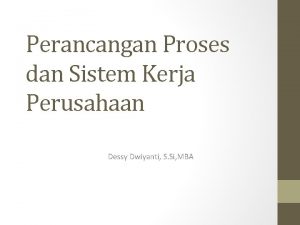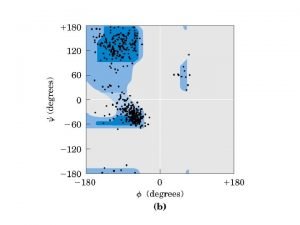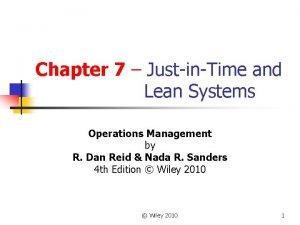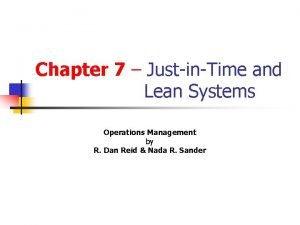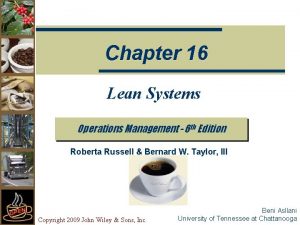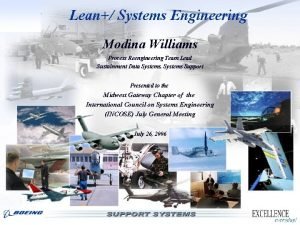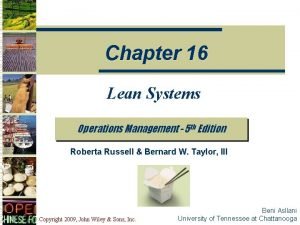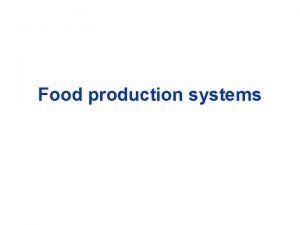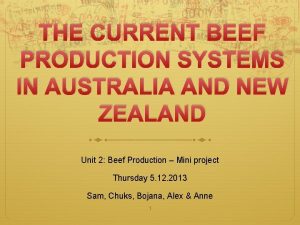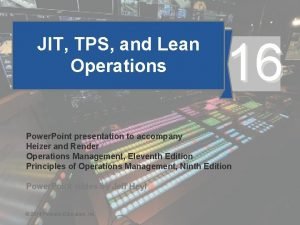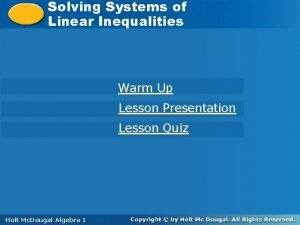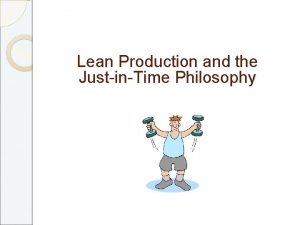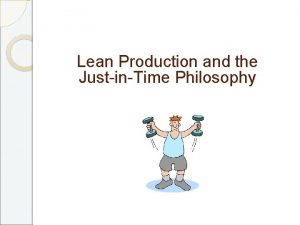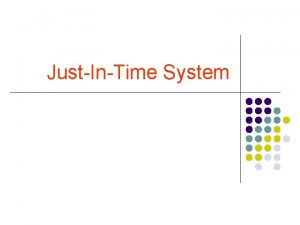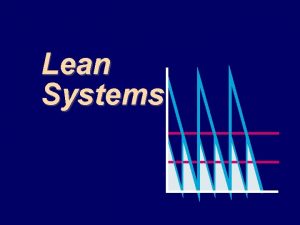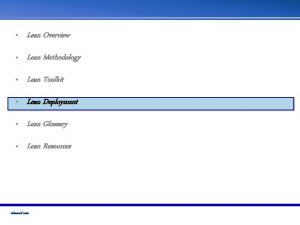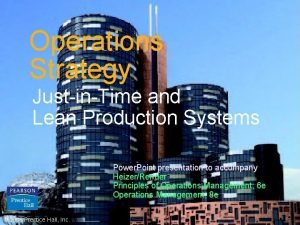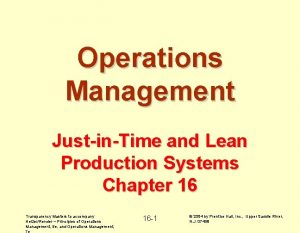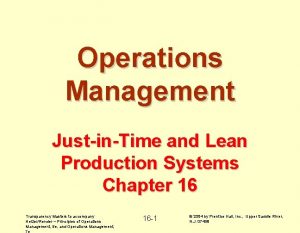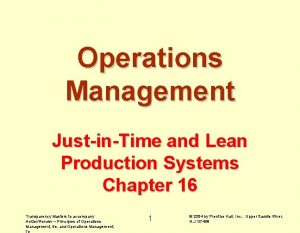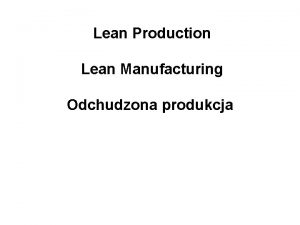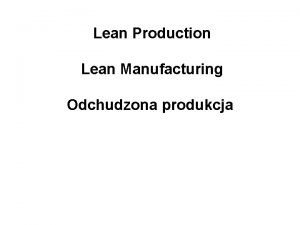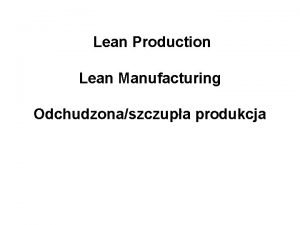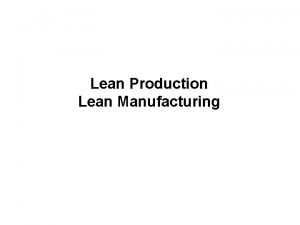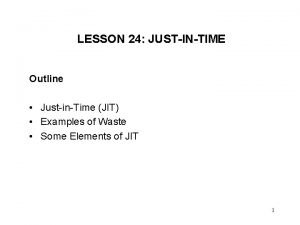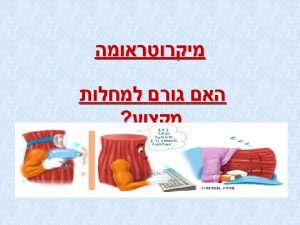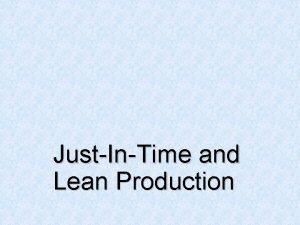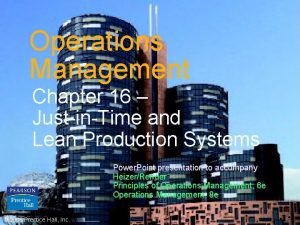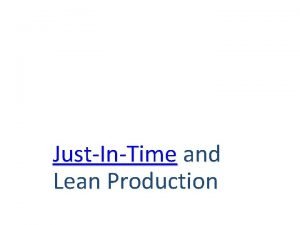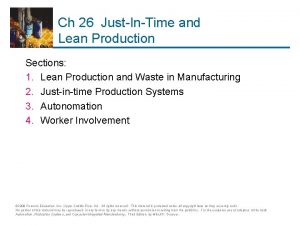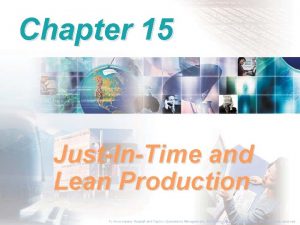Lesson 19 JustInTime and Lean Systems repetitive production










































- Slides: 42

Lesson 19 Just-In-Time and Lean Systems repetitive production system in which processing and movement of materials and goods occur just as they are needed, usually in small batches developed by Taiichi Ohno at Toyota 1

What Is JIT Raw materials, parts & sub assemblies are pulled. Management philosophy (produce through the manufacturing only what is needed when it is needed) process when they are. Pull system needed. What Is JIT is a manufacturing philosophy involving an integrated set of procedures/activities designed to achieve a high volume of production using minimal inventories (raw materials, work-in- Simply put, JIT is a philosophy of “make what is needed … when it is needed”. 2

What Is JIT Ultimate Goal Supporting Goals A balanced rapid flow Eliminate disruptions Make the system flexible Product Design Process Design Eliminate waste Personnel Elements Manufacturing Planning Building Blocks 3

Comparison Of JIT & MRP JIT MRP Repetitive production Lot size or batch production Minimal shop floor control Extensive shop floor control Simpler More complex Relies on visual or audible signals to trigger production and inventory (e. g. auto carpets) Relies on computer system to trigger production and order inventory Lower inventories related to need “at the time” Inventories related to batch or lot sizes 4

What JIT Does Makes the manufacturing delivery system flexible or more robust … allowing it. Attacks waste to handle a variety of. Exposes problems & bottlenecks products and changes in the. Achieves streamlined production level of output while still maintaining balance and Eliminate disruptions in throughput speed. Eliminates waste production … caused by poor quality, equipment breakdowns, schedule changes, late deliveries Reduces setup and delivery times What JIT Does 5

Waste includes any operation, movement, inventory, processing, reporting, etc. which does not add value to the resulting product. Areas of waste include, but are not limited to: . Overproduction. Processing waste. Waiting time. Inefficient work methods. Excess Inventory. Unnecessary movement. Product defects … rework. Setup time. Excess motion. Machine breakdown 6

Strategies For Minimizing Waste We have already discussed many strategies for minimizing waste. Some of these include: Cellular Layouts Lathe Mill Drill Heat Grind Lathe Mill Heat Grind Assembly Focused Factories Drill Grind Group Technology Layouts 7

Strategies For Eliminating Waste Considerations in Job Design aimed at improving worker productivity and skill levels. Specialization Multi-functional workers Behavioral Approaches to Job Design Teams Methods Analysis Motion Study Working conditions Incentive pay plans 8

Strategies For Eliminating Waste On-hand inventory 100 – Manufacturing in smaller lot sizes reduces excess inventory Average cycle inventory 75 – Lot size = 100 50 – Lot size = 50 25 – 0– 5 10 15 20 25 30 Time (hours) 9

Strategies For Eliminating Waste Reducing inventory levels Excess inventory hides allows the problems to be problems in the uncovered … thus creating manufacturing process opportunities for manufacturing process improvement. Machine downtime Scrap Work in process queues (banks) Paperwork backlog Vendor delinquencies Engineering design redundancies Inspection backlogs Change orders Design backlogs Decision backlogs 10

Strategies For Eliminating Waste Setting-up a machine to perform a task is very time consuming. Efforts toward improving product flow, having the right equipment at the right place at the right time, and simple techniques can be used to minimize product change set-up waste. Some simple techniques include: ice Presetting operational settings Using quick fasteners & quick change tools Using locator pins Preventing misalignments Making movements easier Multi-functional machines Scheduling product flow to minimize changeover (e. g. cream) 11

What JIT Requires Product/Process Design standard parts, modular design, quality, setup time reduction, production flexibility, etc. planning Manufacturing . Product Design. Process Design. Employee participation. Industrial engineering/basics and control - level loading, . Continuing improvement small lots, pull systems, . Total quality control visual systems, close vendor. Small lot sizes relationships, reduced. Vendor relations transaction processing Personnel/Organizational elements - regard workers as assets, cross trained workers, continual improvement, cost accounting, leadership and project management 12

What JIT Requires Standardization of product design refers to the absence of variety in products/services. interchangeable parts, modular design (fewer items). reduced time for training workers. may require less effort (purchasing, facilities, inventory management) 13

What JIT Requires Design Simplification Original design Revised design Final design 14

What JIT Requires Concurrent Engineering brings all interested parties together early in the design process to deal with issues associated with design, marketing, manufacturing, quality, supply, etc. Manufacturing can identify production capabilities, capacities, materials, and design alternatives to assist inearly efficient manufacturability. Identifies opportunities for special tooling, equipment, training, etc. some of which have long lead times. Early consideration of technical feasibility of a design Can shorten overall “time to market” 15

What JIT Requires Design a facilities layout & process flow of work that allows for Linked operations Balanced workstation capacities Flow efficiency Small lot sizes Reduced setup/changeover time 16

What JIT Requires Small lot production requires Less space Less capital investment Less inventory Moves processes closer together Makes quality problems easier to detect Makes processes more dependent on each other 17

What JIT Requires Uniform production. Smooth production requirements. Smooth demand across planning horizon. Use mixed-model assembly to steady component production 407 . Use visual system to manage product movement. Can handle up to 10% change in demand 409 410 412 408 411 18

What JIT Requires Visual Systems. A card or other device that communicates demand for work or materials from the preceding work station … sometimes referred to as a kanban system. Work can not move from one station to the next unless authorized by the kanban card. Work is actually “pulled” pulled through the process in this system in containers of parts/subassemblies from one station to the next … a “push” push system moves work from one work station to the next as it is produced whether the next station is ready or not. 19

What JIT Requires Implement a system of Total Productive Maintenance (TPM) designed to improve. Breakdown maintenance (quickly repair machines that have failed). Preventative maintenance (periodic inspection & maintenance aimed at keeping machines operational and in “tip-top shape) 20

What JIT Requires Considerations need to be given to respect for personnel issues of. Pay. Management issues (feeling threatened of losing control). People issues (getting along with each other). Continuous Improvement. Total employee involvement. Empowerment. . ability to make changes in their work environment. . spot quality problems. . halt production when necessary. . generate ideas for improvement. . analyze problems 21

What JIT Requires Evaluation and selection of vendor (suppliers) network to develop a tiered supplier network – reducing the number of primary suppliers. Traditional Supplier Network Tiered Supplier Network Buyer Suppler Suppler Suppler Suppler 22

What JIT Requires The criteria usually used to evaluate a vendor network include. Reduced & highly reliable lead times. Flexibility & smaller lot sizes. Frequency & reliability of delivery. Reliability (variability) of delivery. Consistently high quality. Willingness to work together. . Commitment (“pig not a chicken”). . Future development. . Product improvements. . Exchange of 23

What JIT Requires Contractual Issues need to be worked out to protect both the customer & vendor. Some of these include: . Long term contracts with minimal paperwork establishing the purchase quantities with the ability to ship variable quantities through out the term. . Accuracy requirements in both shipment quantities & quality standards. Cost issues (who pays for storage costs on unreleased materials, re-tooling, containers, etc. ). While it may seem that some of these issues flow from customer down through the supplier network, the nature of the relationship (private label vendor) may allow for negotiation. 24

What JIT Requires Quality Issues need to be worked out to protect both the customer & vendor. Some of these include: . Quality levels (AQL, LTPD, etc). Working relationship between customer & vendor Quality Control personnel. Suppliers encouraged to use Statistical Process Control during the manufacturing process. . Acceptance Sampling prior to shipping may be reduced/eliminated depending on customer satisfaction with SPC results. Conflict resolution guidelines 25

What JIT Requires Some recent trends in vendor requirements are. Willingness to locate near customer. Use of smaller side loaded trucks. Shipments of mixed loads. Consolidation of warehouses with other suppliers. Use of standardized containers. Make deliveries according to a precise delivery schedule. Become a certified supplier. Accept payments on a regular interval rather than upon delivery 26

JIT Benefits Improved vendor relations . Many Simplified scheduling & control Reduced Inventory Increased capacity Improved quality Better utilization of personnel Lower costs Reduced space requirements Shorter lead-time Increased productivity Greater flexibility More product variety Increased equipment utilization Reduced paperwork Valid production priorities 27

JIT … Not For Everyone JIT concepts work best when goods can be produced in response to consumer demand; thereby, eliminating the need for large build-ups of inventory (e. g. automobiles, motorcycles). This is referred to as a make to order environment. JIT is less effective and is less likely to be used for the production of standardized consumer goods (e. g. basic clothing, food, soft drinks, toasters, etc. ) This is referred to as a make to stock environment. However, there are cases where JIT concepts apply to subprocesses of a make to stock environment. Consider a computer manufacturer (e. g. Dell). Computers can be 28

Planning A Successful JIT Implementation Planning a successful JIT implementation requires. Top management commitment. Assessing operational conversion difficulty & prioritizing conversion sequence. Getting support of the work force … training programs, cross training plans, problem solving procedures, pay plans. Begin by trying to reduce the setup times while maintaining the current system … involve work force in problems. Gradually convert operations … begin at end … work toward beginning 29

Obstacles To Conversion Obstacles to Conversion must be addressed. . Management. Workers - may not want more responsibility or stress. Suppliers - why should we? , other customers don’t require this, can not get their management to commit, smaller quantities may not be feasible 30

Level Loading … Mixed Model Production Suppose a department produces 3 models with daily quantities shown here. There are 3 issues that need to be resolved: Which sequence to produce? C-B-A, A-B-C, B-A-C How many times (cycles) the sequence should repeat? How many units to produce in each cycle? 31

Level Loading … Mixed Model Production Which sequence to produce? C-B-A, A-B-C, B-A-C Involves many factors. Usually the most important is the setup time or cost involved. This may vary depending on the sequence used. For example, if the process for A and C are similar and require little change from one product to the other and the changes to product B require extensive changes then the sequences A - C - B or C - A - B, would be more efficient and less costly than the sequence A - B - C or C - B - A. as shown in the next schematic. 32

Level Loading … Mixed Model Production Which sequence to produce? C-B-A, A-B-C, B-A-C A-CB Little change Major change A-BC Major change C-AB Major change Little change C-BA Major change Little change 33

Level Loading … Mixed Model Production How many times (cycles) the sequence should repeat? The steps involved are: . Determine the number of cycles = the smallest integer that can be evenly divided into the daily production quantities . Determine the units to be produced for each cycle = daily quantity divided by the number of cycles. Determine the load level for each cycle 34

. Level Loading … Mixed Model Production Example 1 b: A JIT production manager wants to plan production (as level as possible) for these three models using the manufacturing sequence A-B-C. . First, determine the number of cycles = the smallest integer that can be evenly divided into the daily production quantities Since there is no integer that will divide all 3 numbers, we will choose the minimum daily quantity of 5 as the number of cycles. 35

Level Loading … Mixed Model Production Next, determine the units to be produced for each cycle = daily quantity divided by the number of cycles 36

Level Loading … Mixed Model Production Next, determine the load level for each cycle A perfectly level loaded production plan would look like this; but we are short 3 -A’s and 1 -B. 37

Level Loading … Mixed Model Production Depending on the JIT production manager’s choice the final loading schedule might look like this. There is no correct answer to this problem. The objective is to level production as much as possible given the costs of setup and change over. The manager just as easily have considered the following production plan with exactly the same costs as the previous one. 38

Visual Kanban System Setting up a visual (Kanban) system. requires determining the number of containers (kanbans) needed. each container represents the minimum production lot size. an accurate estimate of the lead time required to produce a container is key to determining how many kanbans are required. . The number of kanbans needed to support the operation is calculated by the following formula: 39

How Many Kanbans? 40

How Many Kanbans? Example 2: Usage at a work center is 300 parts per day, and a standard container holds 25 parts. It takes an average of. 12 day for a container to complete a circuit from the time a kanban card is received until the container is returned empty. Compute the number of containers needed to support the operation if the policy variable is. 20. Therefore, it will take 2 kanban containers to meet the process requirements 41

Homework Read and understand all material in the chapter. Discussion and Review Questions Recreate and understand all classroom examples Exercises on chapter web page 42
 Justintime production
Justintime production Alur produksi multimedia
Alur produksi multimedia Lean production and quality management
Lean production and quality management Jit and lean manufacturing
Jit and lean manufacturing Repetitive and product oriented layout
Repetitive and product oriented layout Difference between rhythm and beat
Difference between rhythm and beat эътиборингиз учун раҳмат
эътиборингиз учун раҳмат Lean operations and systems
Lean operations and systems Repetitive nearest neighbor algorithm
Repetitive nearest neighbor algorithm It is a repetitive process in which algorithm calls itself.
It is a repetitive process in which algorithm calls itself. Repetitive signal
Repetitive signal Example of repetitive process
Example of repetitive process How to automate repetitive tasks in excel
How to automate repetitive tasks in excel Janice eng
Janice eng What type of line is used with the following symbols and
What type of line is used with the following symbols and Contoh struktur perulangan
Contoh struktur perulangan Process focus strategy example
Process focus strategy example Repetitive focus strategy
Repetitive focus strategy Interniten
Interniten Non repetitive secondary structure
Non repetitive secondary structure Ocd repetitive thoughts
Ocd repetitive thoughts Lean systems operations management
Lean systems operations management Lean systems operations management
Lean systems operations management A production kanban authorizes a worker to:
A production kanban authorizes a worker to: Lean systems engineering
Lean systems engineering Lean systems operations management
Lean systems operations management Restaurant kitchen production systems
Restaurant kitchen production systems Terrestrial production system
Terrestrial production system Types of food production systems
Types of food production systems Textiles production systems
Textiles production systems Beef production systems
Beef production systems Decision support systems and intelligent systems
Decision support systems and intelligent systems Engineering elegant systems: theory of systems engineering
Engineering elegant systems: theory of systems engineering Embedded systems vs cyber physical systems
Embedded systems vs cyber physical systems Engineering elegant systems: theory of systems engineering
Engineering elegant systems: theory of systems engineering What is microteaching lesson plan
What is microteaching lesson plan Sat vocabulary lesson and practice lesson 4
Sat vocabulary lesson and practice lesson 4 The science duo physical and chemical changes
The science duo physical and chemical changes Lesson 4 gravity and motion lesson review
Lesson 4 gravity and motion lesson review Lesson outline lesson 1 magnets and magnetic fields
Lesson outline lesson 1 magnets and magnetic fields The sun-earth-moon system worksheet answers lesson 1
The sun-earth-moon system worksheet answers lesson 1 Jit tps and lean operations
Jit tps and lean operations 4-5 lesson quiz systems of linear inequalities
4-5 lesson quiz systems of linear inequalities
